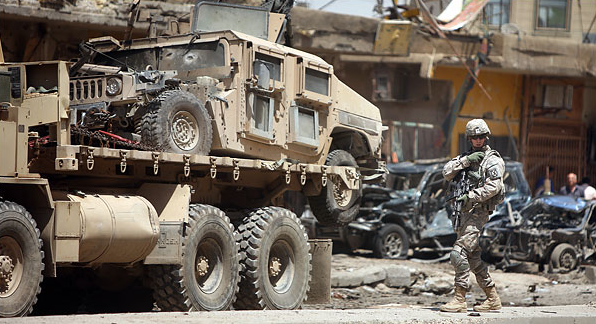Although a democracy requires constant vigilance regarding censorship, too little attention is paid to how bad news is hidden in plain view. It often is enough to frame disclosures within a larger context of justification–the war on terror, the economy, the electoral campaign–and it certainly helps to treat them as just the daily news, page 6, nothing special. Both strategies are evident in a recent report in the New York Times that included this photo:
The report was titled “Double Bombings in an Iraqi town Kill 35 and Wound 62.” Awful, right? And that’s before you know that the attackers were targeting both a wedding caravan and the medics that arrived after the first explosion. The words “civil war” never appear in the story, however. What does appear is the photograph, but it shows the aftermath of a third bombing, one in Baghdad that killed nine Iraqis and one US soldier. So, the news about the continuing (escalating?) carnage throughout Iraq is there but not there, in print but displaced by this photograph (and another as well) about an assault on US troops. And in this photo we see not the dead or wounded but rather an able-bodied soldier working like a traffic cop after an accident. The war could be smackdown between SUVs and other vehicles, not a bloody cycle of violence killing thousands of civilians. The bad news is reported, but it becomes easy to see it as something else.
But even this photograph reveals too much, so it had to be framed with this caption: “An American soldier secured an area on Baghdad on Thursday after a car bombing killed a soldier and nine Iraqis. An American patrol seemed to be the target.” Now look at the photo, and keep in mind that you are looking at a “secure area.” Does it look secure, or would “wrecked” be closer to the truth? The cars in the background are destroyed and the shops along the street have been seriously damaged. Rubble and debris can be cleaned up, but the trauma will extend well beyond the physical wreckage. (Two Americans and 23 Iraqis were wounded.) Note also the damaged Humvee being towed away. The costs extend in every direction, which is how the US can spend $341,000,000 per day on the war. The soldier who supposedly is doing the securing seems to be following the tow truck while talking into his radio, probably to report that the mission has been accomplished. In short, securing the area means deploying troops to allow removal of the dead and wounded and any damaged equipment, then leaving again. It does not mean rebuilding Iraq.
The road in the photograph used to be called Death Road because of all the explosions, but it had been quieter lately. Secure, one might have said, until this bomb, which one shopkeeper said was the worst of the 19 bombings he has seen on the street. The news is not good and current US policy is not going to make it better, but that’s hard to see when right there in plain view.
Photograph by Moises Saman for the New York Times.

Apparently the entire Diyala region has been secure for some time — except it hasn’t been. The coalition military has conducted operations in the area for the past several years and been declaring success each time — but the “insurgents” return and there is seemingly no end to the killing and destruction . Yeah, I guess 100 years sounds about right. The link below is an example of the military propaganda mill at work.
http://www.dvidshub.net/?script=news/news_show.php&id=10245
Your post led me to google “Balad Ruz” and it was an eye-opening exercise.
[…] No Caption Needed wrote an interesting post today on Hiding the News in Plain SightHere’s a quick excerpt Although a democracy requires constant vigilance regarding censorship, too little attention is paid to how bad news is hidden in plain view. It often is enough to frame disclosures within a larger context of justification–the war on terror, the primary campaign, the economy–and it certainly helps to treat them as just the daily news, page 6, nothing special. Both strategies are evident in a recent report in the New York Times that included this photo: The report was titled “Double Bombings i […]
wedding photojournalism…
Good websites come now and then; thanks for yours, and I won’t forget to bookmark for future visits, and I enthusiastically recommend to others!…
Non-believers do have valid questions. ,